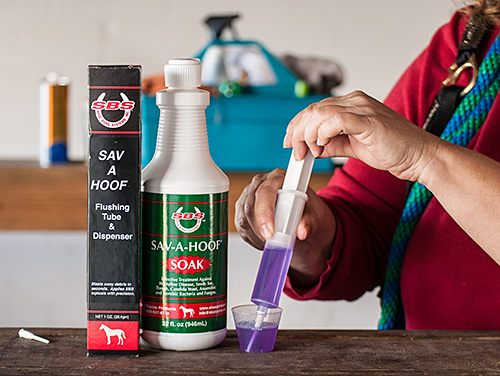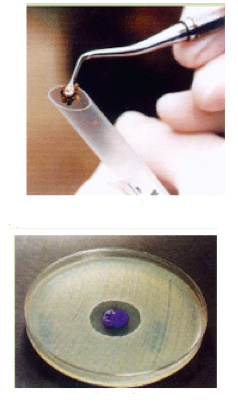 |
|
Simple Flushing Tool Effective Against Hoof Disease!
Contributions by Dr. Richard Shakalis & Dr. John Pautienis for SBS Equine
According to hoof researchers, the most important step in fighting hoof disease is cleaning the feet and removing diseased tissue.
SBS is committed to this process. That is why they have introduced a simple cleaning tool that is
powerful enough to blow a stream of water 35 feet in 1.5 seconds. Using a simple saline solution, this tool
can safely flush out deeply rooted debris where harmful organisms thrive and open up these areas to
oxygen. Bacteria hate oxygen. The tool can also deliver controlled amounts of topical agents such as Sav
-A-Hoof Soak with pinpoint accuracy into cracks and voids without harming healthy tissue.
What is white line disease?
 Researchers have spent a great deal of time trying to find the single organism that
causes the destruction of hoof wall at the stratum medium, referred to as white line disease. The hope is that the discovery of the elusive bacteria or fungus will result in a definitive cure.
Unfortunately, this approach is too simplistic for the complex biological event that is actually taking place. White line disease is
caused by two different types of opportunistic microorganisms that exist in a symbiotic relationship.
Together they produce enzymes and exotoxins that break down the protein and collagen of the hoof wall.
This dynamic colony of microorganisms consists of at least one type of destructive bacteria and at least one fungus. Researchers have spent a great deal of time trying to find the single organism that
causes the destruction of hoof wall at the stratum medium, referred to as white line disease. The hope is that the discovery of the elusive bacteria or fungus will result in a definitive cure.
Unfortunately, this approach is too simplistic for the complex biological event that is actually taking place. White line disease is
caused by two different types of opportunistic microorganisms that exist in a symbiotic relationship.
Together they produce enzymes and exotoxins that break down the protein and collagen of the hoof wall.
This dynamic colony of microorganisms consists of at least one type of destructive bacteria and at least one fungus.
This information explains quite a bit. First, because it is not caused by a single organism, white line disease
may appear different from horse to horse, depending on the particular makeup of the colony of
microorganisms present. For example, if there is a very aggressive fungus present mixed in with a virulent
bacterium, a fast-growing, hard-to-treat case will result. Conversely, if a slow-growing, less invasive
fungus is paired with a more benign bacterium, this case can be treated more easily. There may be two or
more destructive bacteria or fungi present in the same hoof. You can begin to understand that an infinite
number of combinations can result. This also explains why a certain treatment may work effectively in one
case and fail miserably on the next. To add another variable to the mix, these colonies are dynamic and grow faster when the environment is wet and warm, and slower when it is cold and dry.
In white line disease, bacteria and fungi live within the confines of the hoof wall in a symbiotic relationship.
That is, they can live independently, but mutually benefit by each other’s presence. Each organism breaks
down the hoof in a different manor while providing metabolites for the other. The fungi can be
heterotrophs, obtaining their food from nonliving organic matter, or saprophytes, feeding as parasites on
living hosts. They become deeply embedded within the hoof wall and send out threadlike filaments called
hyphae that absorb nutrients much like roots of a plant. The bacterium reproduces more quickly by
dividing, but the fungus can produce spores that makes it harder to kill. Treating for bacteria or fungus
alone is useless because when one is eliminated, the other will continue to grow unabated. You must control both simultaneously.
 In testing for white line disease, diseased hoof material was
removed deep from within the hoof wall, along the leading edge of the infected area, and placed in sterile culture containers. Then these samples went to the laboratory technicians for analysis
(figure 2). In testing for white line disease, diseased hoof material was
removed deep from within the hoof wall, along the leading edge of the infected area, and placed in sterile culture containers. Then these samples went to the laboratory technicians for analysis
(figure 2).
So what did we find from this mixed bag culture of micro-organisms? We ran the gamut, as one would expect, from very
harmful to relatively benign bacteria, as well as a stubborn fungus in our samples. In every case, the over-the-counter product we
tested – Sav-A-Hoof Gel – worked extremely well at killing both bacteria and fungus (Figure 4).
What are the best ways to fight Hoof Disease ?
Deeply rooted infections like white line disease or chronic thrush are impossible to kill with one application of a powerful topical
agent. Repeated use of these strong chemicals can be harmful to the surrounding healthy hoof tissue and slow the healing process.
SBS researchers have developed formulas that stop bacteria and fungi without harming the sensitive surrounding tissue. These formulas are benefitial because they are not caustic and can be
used as often as necessary to keep infection under control and give healthy hoof tissue a chance to prosper.
Summary.
 The best ways to fight hoof disease
are - (1) Cleaning & Trimming: Have the farrier trim and remove diseased tissue and flush away deeply rooted debris from cracks and voids with SBS’s flushing tube. This will open
up these areas to oxygen and clear pathways for topicals treatments to reach their target. (2) Treatments: Apply SBS Topicals such as Sav-A-Hoof, Toe Grow, or Thrush Stop to
affected areas within 30 minutes after flushing. These products do not harm healthy hoof tissue. (3) Hoof Protection: Seal-out pathways of infection with SBS hoof condtioners
such as Farrier’s Hoof Sealant II, TOPCOAT Hoof Conditioner, or Sav-A-Hoof Protectant. These products last longer because they cure (dry) on the hoof wall rather than
remain fluid (wet) like hoof oils and hoof dressings. For more information go to www.sbsequine.com. The best ways to fight hoof disease
are - (1) Cleaning & Trimming: Have the farrier trim and remove diseased tissue and flush away deeply rooted debris from cracks and voids with SBS’s flushing tube. This will open
up these areas to oxygen and clear pathways for topicals treatments to reach their target. (2) Treatments: Apply SBS Topicals such as Sav-A-Hoof, Toe Grow, or Thrush Stop to
affected areas within 30 minutes after flushing. These products do not harm healthy hoof tissue. (3) Hoof Protection: Seal-out pathways of infection with SBS hoof condtioners
such as Farrier’s Hoof Sealant II, TOPCOAT Hoof Conditioner, or Sav-A-Hoof Protectant. These products last longer because they cure (dry) on the hoof wall rather than
remain fluid (wet) like hoof oils and hoof dressings. For more information go to www.sbsequine.com.
The authors are hoof researchers and co-founders of SBS Equine products.
Contact: SBS Equine Products
800-637-6174
sbsequine.com
info@sbsequine.com
|
 |
 |
|
To advertise your horse product or service, Contact Ann
|
|
|
InfoHorse.com, Horse Information Lives Here ® 12/5/2025
Contact Us to Advertise to over a million Horse Owners.
All images and content Copyright© 2013 by InfoHorse.com, Equusite.com.
Horse Owners are Dog Owners; Dog Product Information dognowner.com
|
|
|
|
Articles, Academic Schools, Arena Maintenance, Animal Communicators, Barns, Barn and Accessories, Barn Equipment and Tractors, Breast Collars, Grooming Products for Horses, Hay Feeders, Horse Blankets, Horse Books, Horse Videos, Horse Breeders, Horse Camping Gear, Career Schools, Carts and Buggies, Horse Training Clinicians, Equestrian Clothing, Dogs and Puppies, Horse Fencing, Western Art & Furniture, Horse Property for Sale, Horse Products For Sale, Fly Control, Foal Care, Horse Footings, Horse Gifts, Horse Health and Nutrition, Hoof and Leg, Horse Insurance, John Lyons Certified Trainers, Equine Lawyers, Leather Care, Links, Horse Property, Horse Photography, Portable Horse Stalls, Arenas and Roundpens, Horse Riding Schools, Horse Schools, Safety Products, Services for Horses, Horse Trailers, Horse Shipping, Horse Skin Coat Care, Horse Software, Specialty Trainers, Horse Summer Camps, Tack, Horse Trainers, Treats and Snacks, Truck Accessories, Trucks, Horse Vacations, Western Lifestyle, jewelry
|
|
|
|
|